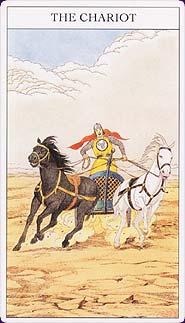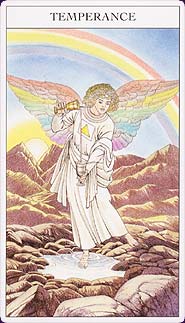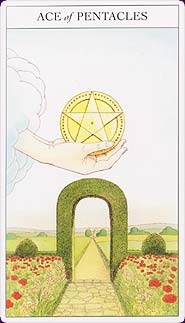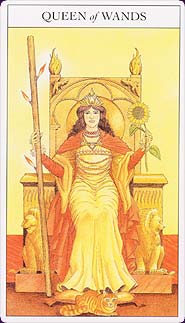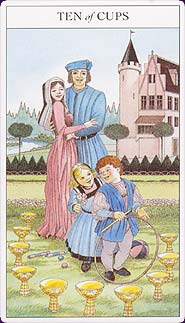Beginner's Guide to Tarot Deck Review
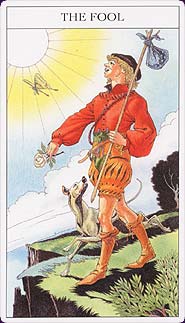
Creators: Juliet Sharman-Burke, Giovanni Caselli
Published: 2002
The Beginner's Guide To Tarot is an ideal kit for the novice tarot reader. There are a clearly and attractively illustrated set of 78 cards inspired by the Rider-Waite and Visconti-Sforza Tarot decks, and a 192-page book written by Juliet Sharman-Burke.
Retailers
See Price at Amazon.comSee Price at Amazon.co.uk
See Price at Amazon.ca
Beginner's Guide to Tarot Review by Christopher Butler
I cannot praise this deck highly enough, not just for its outstanding artwork but for the numerous practicalities of its presentation. Indeed, all involved deserve a lot of praise. The deck can only be bought as part of a fairly lavish package, titled the Beginners Guide to the Tarot. In simple terms, if you want the deck, you have to buy the deck and book set - bad news on the wallet, I hear many people say, particularly experienced readers who really don't need another introductory book to add to their collection. The great news here is that not only would the book still be an asset to anyone's Tarot library, no matter how advanced, the whole glorious package retails for around the price of a standard U.S. Games tarot deck, making it in my book just about the best bargain I've ever added to my collection.
Dealing firstly with practicalities, the high quality paperback book has an elaborate fold out cover which houses the cards. If you want to store the cards separately then this extension can be trimmed off, leaving you with a regular sized paperback book. The cards are printed on attractive, silk finish card stock with very neatly rounded edges. The stock may not be quite up to the quality of Carta Mundi or the high gloss offerings to emerge from U.S. Games of late but I've found it to be quite acceptable and easy to shuffle.
In terms of presentation, the book is teaming with monochrome illustrations taken from the deck itself. A particularly nice touch however, is that dark blue ink, rather than black has been used both for text and illustrations, making the whole presentation much softer on the eye. The cards are presented with plain backs wich are a vivid shade of cerise, The only detail is a thin silver border about 3/4 cm in. This sounds gawdy but it works well in the context of the artwork and does not detract from it in any way.
Moving on to the proper content of this set, it really is difficult to know where to start - mainly because there's just so much that's good and down to earth practical. It's probably best to start with the book. Juliet Sharman Burke is a full time teacher of both Tarot and Astrology. I've already read her 'Understanding' and 'Mastering' the Tarot books as well as this. She is a very good teacher and this, I feel is her best offering to date. She is a total no - nonsense, level headed tarot practitioner and the perfect guide for the novice while being able to offer new insight to the more advanced in the same breath. This package has been available in Britain for some time now. I had always loved the Tarot and been fascinated by it's imagery. When I bought this set and followed the course through I became a good reader as opposed to just a dabbler. For the first time I had a very solid and practical foundation to build on.
Each card is described in individual detail but there are also general overviews of the Majors as a whole and of each suit. She starts with the Minor Arcana which in itself is a brilliant move. You don't even get to the Majors until you've learned all of these card meanings, done sample readings with each suit on its own, then a reading using all four together. You then learn the Majors, do a Majors only reading and finally a reading with the whole deck. Individual card descriptions are detailed but never labourious. Each card gets more or less a full page and is accompanied by a monochrome reproduction of the card itself which is diagrammatically annotated with key points and handy tips.
Sharman - Burke has devised this deck more or less along the lines of the Rider - Waite but she also draws on the other traditional decks such as the Visconti Sforza and the Marseilles. What results is almost an objectified Rider deck - she debunks all of Waite's subjective occult imagery and replaces it with easier to understand symbols. Hence, Waite's rather obscure Alchemical Wheel of fortune with it's sphynxes, serpents and Hermanubises is replaced by the more traditional Fortuna and her Wheel. The occult vision of the Lovers in the Garden of Eden is replaced by the Marseilles image of the Lover choosing between two women. Waite's High Priestess is an odd mixture of a priestess of Isis and Catholic Marian symbolism. Here she is a simple woman, veiled in white wearing the symbol of the moon. Where occult symbols are retained they are explained in full and are there to enhance a card meaning rather than to serve a particular philosophy. Also, numbers are absent from the Major cards. This does away with any arguments over card ordering and leaves you to form your own conclusions. When did it ever matter whether Strength was card 8 or 11 to a novice anyway?
A similar pattern follows through the Minor Arcana which if anything are even richer in detail than Coleman Smith's whilst remaining true to her basic imagery. For me, Juliet Sharman-Burke is the only person who has managed to achieve this. Call it a subjective view on my part but buy the deck and judge for yourself!! What also helps is that each suit has its own consistent colour scheme, making the cards instantly recogniseable. Colours are related to elements and the elemental attributions are standard - Pentacles - Earth. Swords - Air. Wands - Fire. Cups - Water.
If you want to change your mind later, with regards to suit names and elemental attributions as I did when designing my own deck then that's fine but everyone needs to know where the majority of traditional opinion lies and for the beginner this is admirably portrayed.
With all the cards, pay attention to detail for every expression and every gesture, even down to the direction a character is facing has significance. The author is shrewd enough to know such precision amplifies meaning and aids learning.
As to purely artistic concerns, the deck, though devised by Juliet Sharman-Burke in every detail was painted by Giovanni Casselli. Its a masterpiece of line and wash style which is elegant, refined and manages to totally avoid the comic strip style trap that many decks can fall into. It really is a gorgeous deck that can hold its own with the best of the rest.
Although aimed at beginners, this package is far more than just an introductory course. It is a timeless deck and book that will continually provide pleasure and insight no matter how far advanced you are. As such it should be a required acquisition to any serious collection as well as the best recommended starting point for anyone interested in learning the art of Tarot.
Beginner's Guide to Tarot Review by Solandia
The Sharman-Caselli Tarot is a quality deck designed for the Tarot beginner by Juliet Sharman-Burke and Giovanni Caselli, and it's now more widely available than ever before.
Juliet Sharman-Burke is a practicing psychotherapist, has written several tarot books, including Understanding the Tarot and Mastering the Tarot and was co-author on the Mythic Tarot, while Caselli is a professional illustrator. Their cards created for the Sharman-Caselli Tarot have recognisable links with the Rider-Waite Tarot, but they have also been inspired by Visconti-Sforza imagery and influenced by Caselli’s knowledge of history and the classical world. His detailed illustrations in ‘line-and-wash’ art is almost photo-realistic, very clear, subtly coloured and with a great sense of space. It’s like the focus has been sharpened by several magnifications, compared to the Rider-Waite images. Facial expressions are distinct and individual, and we can easily discern the direction of gaze; clothing benefits from a close attention to detail and appears more ‘period’, with hose, gowns and head-dresses.
While the deck draws on historical sources of the occult Western and Italian Tarot tradition, it also makes some changes of its own to emphasise a meaning. The Hierophant does not have any acolytes or sit in a cathedral – he sits, alone, in a desert with a book on his lap. The Tower arises from storm-tossed water. The Ten of Pentacles is very (appropriately, I think) suggestive of Father Christmas with his red cap, throne-type seat, and a child on his knee. In the Six of Cups, one and perhaps both of the people pictured are dwarfs rather than children, as some have argued is the case in the more ambiguously pictured Rider-Waite. The Eight of Wands introduces a man holding a bow, an arrow nocked and seven other wands fanning out around it. And in the Chariot, the horses are running in distinctly different directions – they are not quite so under control or static as in some other decks!
I also like the interpretation of the Empress, who is apparently pregnant and is seated next to a lush field of ripe grain, a waterfall in the background and an overflowing cornucopia at her feet. The court cards are also excellent - the essential quality and personality of the royal is made more obvious through a change in positioning or background. The Knight of Swords has a powerful feeling of forward motion (or headlong flight), the Queen of Cups is pale and ethereal, the King of Swords has a direct and piercing blue stare, while the King of Wands leans forward and grins confidently at you. The court cards especially would be easier for the beginner, as the Sharman-Caselli seems to brings out the personalities on what are often the hardest cards to learn.
The suits are Wands, Cups, Swords and Pentacles, with courts of Page, Knight, Queen and King. The major arcana are un-numbered, so there is no fixed Strength or Justice arrangement. Indeed, the booklet rearranges several other major arcana (presumably to better the life journey of the Fool, but it’s not explicitly explained) into this order:
Fool
Magician
High Priestess
Empress
Emperor
Hierophant
Lovers
Chariot
Justice
Temperance
Strength
Hermit
Wheel of Fortune
Hanged Man
Death
The Devil
Tower
Star
Moon
Sun
Judgement
World
The medium-sized white booklet that comes packaged with the cards has 64 pages, starting with an introduction to the deck. Each card has a half-page section and a black and white image reproduction, with the title, element, symbolism (that explains the major symbols or body language in the cards), and theme (keyword). The back of the booklet has a sample reading with the Horseshoe Spread for Catherine, a women asking about her career and family life.
Ace of Pentacles
Element: Earth
Symbolism: The open arch symbolizes the freedom to move on. The border hedge represents a container. The beautiful garden shows nature’s bounty. White lilies symbolise the spirit. Red roses symbolise passion.
Theme: A gift or financial opportunity.
Originally only available as an unwieldy cardboard book and cards set titled the Beginners Tarot Set, the Sharman-Caselli Tarot cards are now available individually and more conventionally alongside a small booklet in a sturdy matte case. The cards are also being published in several other versions – with black and white cards suited for colouring in the My Tarot, and miniature cards with booklet in the witchy-looking Tarot Box, all published by Connections. In this set the cards have a very light laminate (comparable to the Fairytale Tarot or Tarot of Prague), and are not at all glossy. The backs of the cards are very plain, just a pinkish-red with a thin silver line and tiny copyright attributions (thoughtfully placed at both ends of the card so they can be still be used for reversals).
The Sharman-Caselli Tarot is designed for first-time Tarot users and is certainly suitable for beginners who find the Rider-Waite unappealing (though the actual Beginners Guide to Tarot would be the best as it includes a more comprehensive book). The deck alone also has great potential for the more experienced reader, either for use as a professional working deck for querents, or for personal readings. It’s a clear and straight-forward Tarot that draws on historical tradition but offers enough of a new perspective on the old imagery to be interesting.
Complete Details of Beginner's Guide to Tarot
Also known as Sharman-Caselli Tarot, Caselli Tarot
Creators: Juliet Sharman-Burke, Giovanni CaselliPublisher: Connections 2002
Deck Type: Tarot Deck
Cards: 78
Major Arcana: 22
Minor Arcana: 56
Deck Tradition: Rider-Waite-Smith
Minor Arcana Style: RWS-Based Scenes
Suits: Cups, Swords, Wands, Pentacles
Court Cards: Page, Knight, Queen, King
The Fool is na
Strength is na
Justice is na
Card Size: 4.72 x 2.76 in. = 12.00cm x 7.00cm
Card Language: English
Card Back: Reversible
Back Design: Pink with gold border
Companion Material: Companion book and workbook are available to go with the deck.
Rating: 18/20 or
Similar Decks to Beginner's Guide to Tarot
Theme: Beginner, Rider-Waite-InspiredCategory: Available Tarot Decks
Creator: My Tarot, Mythic Tarot by Juliet Sharman-Burke Grail Tarot, New Mythic Tarot by Giovanni Caselli
< Previous Deck · Back to Top · Next Deck >
Home > Tarot Reviews > Beginner's Guide to Tarot Review

